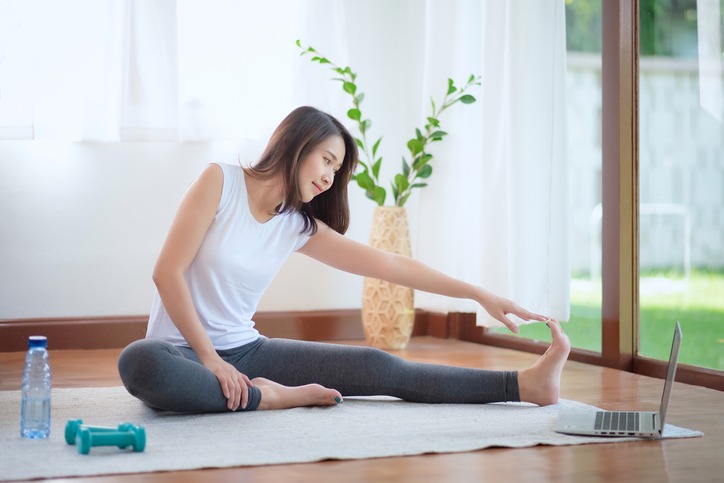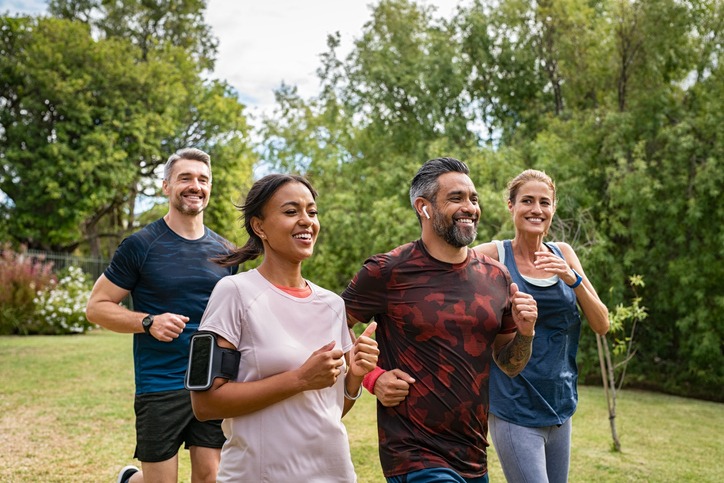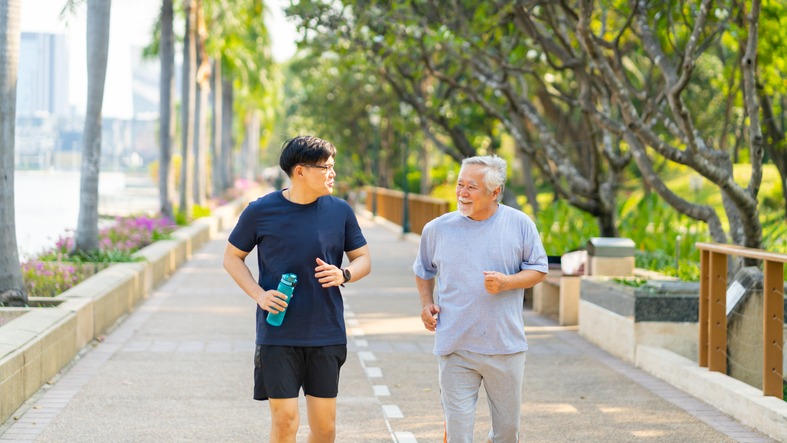The importance of staying active consistently cannot be overstated because of the pivotal part it plays in ensuring one’s continued good health and sense of well-being. There are a variety of advantages associated with physical activity, including enhancements to one’s cardiovascular health, mental clarity, and mood.
In addition to improving one’s physical fitness, engaging in regular physical activity has a positive influence on one’s mental well-being as well as their overall health. It has been demonstrated to improve a person’s self-esteem and cognitive function while simultaneously lowering levels of stress, anxiety, and depression. This article places a primary emphasis on the reciprocal relationship that exists between one’s mental and physical health.
This article provides an overview of how exercise influences both mental and physical health, highlighting the interconnectedness of these two aspects along the way. It investigates the scientific evidence that supports these effects and provides useful insights into how to practically incorporate exercise into daily life to achieve a more holistic approach to health and wellness.
Physical Health Benefits
Weight Management
The role of exercise in burning calories
When combined with a healthy eating plan, exercise is one of the most important factors in achieving a calorie deficit because it helps the body burn more calories through increased physical activity. This deficit is necessary for either weight loss or maintaining a healthy weight.
Preventing and managing obesity
The prevention and management of obesity both benefit greatly from engaging in regular physical activity. It does this by increasing energy expenditure, improving metabolism, and promoting fat loss while maintaining lean muscle mass, which all work together to help control body weight.
Cardiovascular Health
Strengthening the heart and improving circulation
The heart muscle can be strengthened through exercise, particularly through cardiovascular exercises such as running, swimming, and cycling. This increased strength leads to improved circulation, which in turn allows the heart to pump blood more efficiently and reduces the risk of issues related to the heart.
Reducing the risk of heart diseases
By lowering risk factors such as high blood pressure, high cholesterol levels, and obesity, consistent physical activity has been shown to reduce the likelihood of developing cardiovascular diseases like heart attacks and strokes. Additionally, it assists in the preservation of healthy blood vessels as well as the reduction of inflammation throughout the cardiovascular system.
Muscle and Bone Health
Promoting muscle growth and strength
Strength and muscle growth are two benefits that come from engaging in physical activity, particularly resistance training such as weightlifting. This not only improves your physical performance but also speeds up your metabolism, which in turn can assist you in better managing your weight.
Enhancing bone density and reducing the risk of osteoporosis
Walking, running, and weightlifting are examples of weight-bearing exercises. These types of exercises increase bone density and stimulate bone growth. This can help lower the risk of developing osteoporosis, which is a condition in which the bones become fragile and brittle.
Improved Immune System
Enhancing the body’s ability to fight infections
The immune system can be strengthened through consistent exercise. This is accomplished by increasing the circulation of immune cells and enhancing their capacity to fight off infections. Inflammation, which is often associated with chronic diseases and a weakened immune response, can also be reduced by this supplement.
Decreasing the frequency and severity of illnesses
Exercising regularly and at moderate intensity has been shown to reduce the incidence of and severity of common illnesses such as the common cold and the flu. It makes the body better able to defend itself against infectious agents and recover from infections more quickly.
You can have a significant positive impact on your overall physical health by contributing to weight management, cardiovascular health, the health of your muscles and bones, and the function of your immune system if you make regular physical activity a part of your lifestyle and incorporate it into your routine.
Mental Health Benefits
Stress Reduction
The release of endorphins and their stress-relieving effects
Endorphins are naturally occurring chemicals found in the brain that can lift one’s mood and provide relief from stress when they are triggered by physical activity. Endorphins are responsible for the reduction of stress, as well as the induction of feelings of well-being and relaxation.
Coping with daily stressors
Participating in consistent physical activity can provide a healthy and productive way to deal with the stresses of daily life. Exerting oneself physically enables people to direct their attention and energy toward a constructive pursuit, which not only offers a momentary reprieve from the things that cause stress but also contributes to better stress management.
Mood Enhancement
Elevating mood through exercise
It has been demonstrated that physical activity can improve mood by causing an increase in the production of neurotransmitters such as serotonin and dopamine, both of which are involved in the regulation of mood. Because of this, one might experience feelings of happiness and an overall improvement in their emotional well-being.
Reducing symptoms of depression and anxiety
People who struggle with mental health conditions like anxiety and depression may benefit from engaging in complementary treatments like physical activity. There is a correlation between regular exercise and a reduction in the symptoms of these mental health disorders, and improved mental health outcomes can be achieved through exercise.
Cognitive Benefits
Improved memory and cognitive function
Memory, attention, and the ability to solve problems are just some of the cognitive abilities that can be improved through exercise. It does this by increasing blood flow and oxygen delivery to the brain, promoting the growth of new neurons, and supporting neural plasticity. All of these things contribute to an improvement in brain function.
Reducing the risk of neurodegenerative diseases
A lower risk of neurodegenerative diseases like Alzheimer’s and Parkinson’s may be associated with an active lifestyle that includes regular exercise. It appears to have a protective effect on the brain by promoting neural health and reducing the buildup of harmful proteins associated with these conditions. This effect appears to make the brain more resistant to the effects of these conditions.
Better Sleep
Promoting restful sleep and preventing insomnia
Exercising consistently can lead to improved sleep patterns as well as an increase in the amount of time spent sleeping. It makes it simpler for people to fall asleep, increases the depth and quality of their sleep, and makes it less likely that they will experience sleeplessness.
The link between exercise and sleep quality
There is a correlation between regular exercise and better sleep quality because exercise helps regulate circadian rhythms, reduces symptoms of sleep disorders, and shortens the amount of time it takes to fall asleep. Stress reduction is another benefit of physical activity, which is important considering its role as a major factor in the development of sleep problems.
Incorporating regular exercise into your routine not only has positive effects on your physical health, but also offers several benefits for your mental health, such as the reduction of stress, enhancement of mood, improvement in cognitive function, and improvement in the quality of sleep. These benefits contribute to an overall sense of well-being that is both healthier and more balanced.
Exercise Types and Recommendations
Aerobic Exercises
Benefits for cardiovascular and mental health
Activities that get your heart rate up and get your blood pumping, like running, swimming, cycling, and dancing, are all great for your cardiovascular health. They enhance the function of the heart and lungs, improve circulation, reduce blood pressure, and stimulate the release of endorphins, both of which contribute to mental well-being.
Recommended duration and intensity
The American Heart Association suggests that adults complete at least 150 minutes of aerobic exercise per week at a moderate intensity or 75 minutes of aerobic exercise per week at a vigorous intensity, ideally distributed over at least three separate days. You could also try to incorporate both moderate and vigorous levels of activity into your daily routine. Before beginning a new exercise routine, it is important to consult with a healthcare professional, especially if you have any preexisting health conditions.
Strength Training
Building and maintaining muscle mass
Utilizing resistance as a means to build and maintain muscle mass and strength is the goal of strength training, which is also known as resistance training or weight training. Increasing your basal metabolic rate, helping you manage your weight, and bolstering the health of your joints are all benefits of taking this supplement.
Incorporating strength training into a fitness routine
A minimum of two days per week should be devoted to strength training, with the exercises focusing on all of the major muscle groups. This can be accomplished by exercising with free weights, resistance bands, or machinery found in a gym. It is necessary to incorporate exercises for the upper body, the lower body, and the core into your routine. To avoid injuring yourself, you should begin with lighter weights and gradually increase the resistance. You can develop a strength training routine that is both safe and effective with the assistance of a certified trainer.
Flexibility and Balance Exercises
Enhancing overall physical health
Exercises that focus on flexibility and balance, like yoga and tai chi, are beneficial to an individual’s overall physical health because they increase joint mobility, lower the risk of injury, and foster relaxation and stress reduction. In addition, improved posture and alignment may result from doing these exercises.
Reducing the risk of injuries
Exercises that improve flexibility and balance are great to include in a routine because they help reduce the risk of injury, particularly in older people. An increase in flexibility can improve joint mobility and reduce the risk of muscle strains and sprains, while an improvement in balance can reduce the likelihood of experiencing a fall.
To achieve a well-rounded approach to your health and fitness, it is essential to incorporate a variety of different types of exercise into your routine. You can achieve the best possible results for your physical and mental health while simultaneously lowering your risk of injury if you combine different types of exercise, such as aerobic exercise, strength training, and flexibility and balance exercises. Always consult with a healthcare or fitness professional to develop a bespoke exercise program that caters to your requirements and objectives.
Exercise as a Lifestyle Choice
Making exercise a regular part of life
To live a healthy lifestyle, you must incorporate exercise into your daily routine. To make this a reality, you must prioritize exercise as you would any other daily activity. By making time for physical activity, you can ensure that it becomes a habit rather than a chore. Selecting physical activities that you genuinely enjoy is one effective strategy for making exercise more enjoyable and sustainable. Finding activities that you enjoy, whether it’s a leisurely walk in the park, a fun dance class, or a challenging hike, can turn exercise into a pleasurable experience. You can also incorporate exercise into your daily routine by making simple, long-term choices like walking or cycling instead of driving for short distances or taking the stairs instead of the elevator. Small changes like these can add up over time and help you stay active without disrupting your daily routine.
Strategies for overcoming barriers and staying motivated
Keeping up with a consistent exercise routine can be difficult due to the many obstacles that can arise and the natural tendency to lose motivation. It is essential, to triumph over these challenges, to identify and tackle the specific challenges that stand in the way of your exercise routine. This may involve improving your ability to manage your time, overcoming fatigue, or boosting your confidence in yourself. You can improve your chances of staying motivated and on track by forming an accountability partnership with a friend, enrolling in a fitness class, or working with a personal trainer.
Explore a variety of exercises and activities outside of your typical routine to shake up your workouts, which will help you avoid becoming bored and keep your motivation high. Keeping tabs on your development is an effective method of self-motivation because it enables you to observe your progress and recognize your accomplishments. In addition, if you want to add an extra layer of positive reinforcement to your exercise routine, one way to do so is to create a system of rewards for achieving certain milestones. This will make your workouts more enjoyable and satisfying.
The importance of setting achievable goals and maintaining a routine
Setting attainable goals and sticking to a consistent routine is critical when it comes to making exercise a lifestyle choice. Fitness goals that are clearly defined and adhere to the SMART (Specific, Measurable, Achievable, Relevant, Time-bound) criteria provide direction and purpose to your workouts. Whether you want to lose weight, run a marathon, or gain muscle, having a clear goal keeps you focused and motivated. Starting with small, attainable goals and gradually increasing the intensity and duration of your workouts is critical.
Pushing yourself too hard too soon can result in burnout or injury, so gradual progress is essential. You create a structured framework for your physical activities by establishing a regular exercise routine that fits into your daily life. This routine assists you in developing a sustainable exercise habit that is more likely to last in the long run. However, because life can be unpredictable, it is critical to remain adaptable. Don’t be discouraged if you miss a workout or face unexpected challenges. Instead, revise your strategy and get back on track to ensure that your exercise routine remains a dependable part of your lifestyle.
Promoting Exercise in Different Life Stages
Exercise benefits for children and adolescents
Children and adolescents need to engage in regular physical activity to support their growth and development and their overall health. It is beneficial to the density of bones, the strength of muscles, and the fitness of the cardiovascular system. In addition to this, it makes it easier to keep a healthy weight, offers opportunities for social interaction, and contributes to the development of skills.
The role of exercise in maintaining health in adulthood
Exercising is still very important for adults in terms of maintaining their physical health and overall well-being. It helps improve mood and cognitive function, as well as control weight, stress, and the risk of developing chronic diseases such as diabetes and heart disease. The maintenance of healthy muscle and bone mass is another benefit of exercise for healthy aging.
Exercise as a tool for healthy aging and senior well-being
Exercising regularly is becoming more and more essential for older people to do to preserve their independence and quality of life. Participating in regular physical activity can assist in warding off age-related muscle loss, preserving bone density, enhancing balance, and lowering the risk of experiencing falls. In addition to this, it helps keep cognitive function intact, lowers the risk of developing dementia, and improves emotional well-being. Participating in physical activity that is adapted to one’s abilities can make a sizeable contribution to healthy aging.
It is necessary to encourage physical activity at all stages of life if one wishes to maintain their physical and mental health throughout their entire life. Beginning in childhood and continuing through adulthood and into the senior years, physical activity is an essential component in the process of preserving one’s health, warding off disease, and enhancing one’s quality of life overall. The key to maximizing the positive effects of physical activity is to adapt one’s workout routines to the specific requirements and capabilities of each stage of one’s life.
Conclusion
The mental and physical health of an individual can greatly benefit from engaging in regular physical activity. On a physical level, it helps with weight management, cardiovascular health, strengthening of the muscles and bones, and a more robust immune system. When it comes to the mind, physical activity has been shown to reduce stress, boost mood and cognitive function, and promote restful sleep. Due to the multiplicity of benefits that it confers, physical activity is an indispensable component of a healthy lifestyle.
It is in their best interest to give serious thought to making physical activity a regular part of their lives as a commitment to their well-being over the long term. It doesn’t matter if you’re just getting started with your fitness journey or if you’re looking to revamp your routine; the important thing is to begin slowly and gradually increase the intensity of your workouts. Find things that you are good at doing, make your goals attainable, and make physical activity a consistent part of your daily routine. Not only does it provide a physical benefit, but it also gives you a sense of fulfillment and increases your vitality.
It is impossible to overstate the positive effects that consistent exercise has over time on one’s overall health and quality of life. You are making an investment in a healthier and happier future for yourself by adopting physical activity as a lifestyle choice and promoting it throughout the various stages of life. Exercise is one of the most valuable commitments you can make for your well-being because, in addition to its positive effects on your body and mind, it also lowers your risk of developing chronic diseases and improves the quality of your life as you get older. Therefore, let’s get moving and harness the power of consistent exercise to begin our journey toward a life that is both healthier and more fulfilling.






